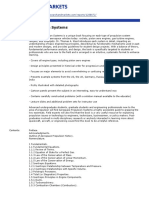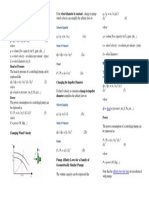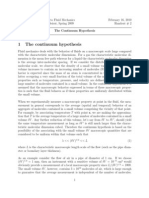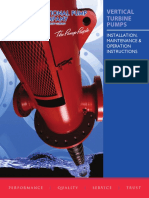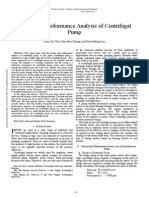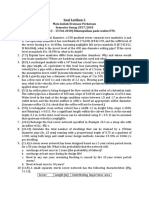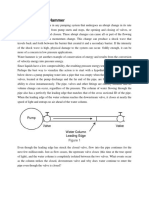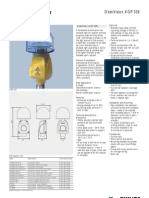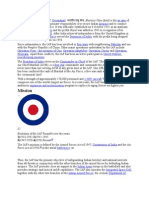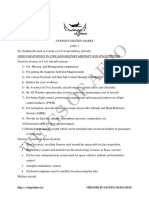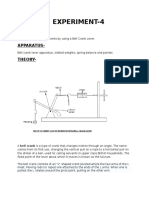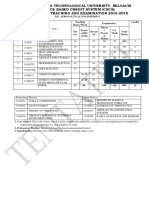Elementary Mechanics of Fluids: Flow in Pipes
Elementary Mechanics of Fluids: Flow in Pipes
Uploaded by
Andre Amba MatarruOriginal Description:
Original Title
Copyright
Available Formats
Share this document
Did you find this document useful?
Is this content inappropriate?
Report this DocumentCopyright:
Available Formats
Elementary Mechanics of Fluids: Flow in Pipes
Elementary Mechanics of Fluids: Flow in Pipes
Uploaded by
Andre Amba MatarruCopyright:
Available Formats
Elementary Mechanics of Fluids
K.2 MATERI MEKFLU II
Daene McKinney
Flow in Pipes
Reynolds Experiment
Reynolds Number
Laminar flow: Fluid moves in smooth streamlines
Turbulent flow: Violent mixing, fluid velocity at a
point varies randomly with time
Transition to turbulence in a 2 in. pipe is at V=2 ft/s,
so most pipe flows are turbulent
>
<
=
2
low f Turbulent 4000
flow Transition 4000 2000
flow Laminar 2000
Re
V h
V h
VD
f
f
Laminar Turbulent
Shear Stress in Pipes
Steady, uniform flow in a pipe: momentum
flux is zero and pressure distribution across
pipe is hydrostatic, equilibrium exists between
pressure, gravity and shear forces
D
L
h h h
ds
dh D
z
p
ds
d D
s D
ds
dz
s A sA
ds
dp
s D W A s
ds
dp
p pA F
f
s
t
t t
t t o
0
2 1
0
0
0
0
4
4
)] ( [
4
) ( 0
) ( sin ) ( 0
= =
=
+ =
A A A =
A A A + = =
Since h is constant across the cross-section
of the pipe (hydrostatic), and dh/ds>0,
then the shear stress will be zero at the
center (r = 0) and increase linearly to a
maximum at the wall.
Head loss is due to the shear stress.
Applicable to either laminar or turbulent flow
Now we need a relationship for the shear
stress in terms of the Re and pipe roughness
Darcy-Weisbach Equation
) (Re,
) (Re,
; Re;
, , : variables Repeating
) , (
) , , , , (
2
0
2
0
2
0
3 2 1
2 1 4
0
D
e
F V
D
e
F
V
V
D
e
D V
F
e D V F
t
t
t
t t t
t t t
t
=
=
= = =
=
=
t
0
V D e
ML
-1
T
-2
ML
-3
LT
-1
ML
-1
T
-1
L
L
) (Re, 8
2
) (Re, 8
2
) (Re,
4
4
2
2
2
0
D
e
F f
g
V
D
L
f h
D
e
F
g
V
D
L
D
e
F V
D
L
D
L
h
f
f
= =
(
=
=
=
Darcy-Weisbach Eq.
Friction factor
Laminar Flow in Pipes
Laminar flow -- Newtons law of viscosity is valid:
(
(
|
|
.
|
\
|
=
= + =
=
=
=
= =
2
0
2
0
2
0
2
1
4
4 4
2
2
2
r
r
ds
dh r
V
ds
dh r
C C
ds
dh r
V
dr
ds
dh r
dV
ds
dh r
dr
dV
dr
dV
dy
dV
ds
dh r
dy
dV
t
Velocity distribution in a pipe (laminar flow)
is parabolic with maximum at center.
(
(
|
|
.
|
\
|
=
2
0
max
1
r
r
V V
Discharge in Laminar Flow
ds
dh D
ds
dh r
Q
r r
ds
dh
rdr r r
ds
dh
VdA Q
r r
ds
dh
V
r
r
t
t
128
8
2
) (
4
) 2 ( ) (
4
) (
4
4
4
0
0
2 2
0
2
0
2 2
0
2 2
0
0
0
=
=
=
}
=
}
=
=
ds
dh D
V
A
Q
V
32
2
=
=
Head Loss in Laminar Flow
2
2 1
1 2
2
1 2
2
2
2
32
) (
32
32
32
32
D
V L
h
h h h
s s
D
V h h
ds
D
V dh
D
V
ds
dh
ds
dh D
V
f
f
=
+ =
=
=
=
=
Re
64
2
2 / ) (
Re
64
2 / ) )( ( 64
2 /
2 / 32
32
2
2
2
2
2
2
2
= =
=
=
=
=
f
V
D
L
f h
V
D
L
V
D
L
D V
V
V
D
V L
D
V L
h
f
f
Nikuradses Experiments
In general, friction factor
Function of Reand roughness
Laminar region
Independent of roughness
Turbulent region
Smooth pipe curve
All curves coincide @ ~Re=2300
Rough pipe zone
All rough pipe curves flatten out
and become independent of Re
Re
64
= f
( )
Blausius
Re
4 / 1
k
f =
Rough
Smooth
Laminar Transition Turbulent
Blausius OK for smooth pipe
) (Re,
D
e
F f =
Re
64
= f
2
9 . 0
10
Re
74 . 5
7 . 3
log
25 . 0
(
|
.
|
\
|
+
=
D
e
f
Moody Diagram
Pipe Entrance
Developing flow
Includes boundary layer and
core,
viscous effects grow inward
from the wall
Fully developed flow
Shape of velocity profile is
same at all points along pipe
~
flow Turbulent 4.4Re
flow Laminar Re 06 . 0
1/6
D
L
e
e
L
Entrance length L
e
Fully developed
flow region
Region of linear
pressure drop
Entrance
pressure drop
Pressure
x
Entrance Loss in a Pipe
In addition to frictional losses, there are minor
losses due to
Entrances or exits
Expansions or contractions
Bends, elbows, tees, and other fittings
Valves
Losses generally determined by experiment
and then corellated with pipe flow
characteristics
Loss coefficients are generally given as the
ratio of head loss to velocity head
K loss coefficent
K ~ 0.1 for well-rounded inlet (high Re)
K ~ 1.0 abrupt pipe outlet
K ~ 0.5 abrupt pipe inlet
Abrupt inlet, K ~ 0.5
g
V
K h
g
V
h
K
L
L
2
or
2
2
2
= =
Elbow Loss in a Pipe
A piping system may have many minor losses
which are all correlated to V
2
/2g
Sum them up to a total system loss for pipes of
the same diameter
Where,
(
+ =
+ =
m
m
m
m f L
K
D
L
f
g
V
h h h
2
2
loss head Total =
L
h
loss head Frictional =
f
h
m h
m
fitting for loss head Minor =
m K
m
fitting for t coefficien loss head Minor =
EGL & HGL for Losses in a Pipe
Entrances, bends, and other flow
transitions cause the EGL to drop an
amount equal to the head loss
produced by the transition.
EGL is steeper at entrance than it is
downstream of there where the slope
is equal the frictional head loss in the
pipe.
The HGL also drops sharply
downstream of an entrance
Ex(10.2)
Given: Liquid in pipe has = 8 kN/m
3
. Acceleration = 0.
D = 1 cm, = 3x10
-3
N-m/s
2
.
Find: Is fluid stationary, moving up, or moving down?
What is the mean velocity?
Solution: Energy eq. from z = 0 to z = 10 m
s m V
* x *
) . *(
. V
L
D
h V
D
LV
h
m h
h
h
z
p
g
V
h z
p
g
V
-
L
L
L
L
L
L
/ 04 . 1
10 10 3 32
01 0 8000
25 1
32
32
upward) (moving 25 . 1
10
8
90
10
8000
000 , 110
8000
000 , 200
2 2
3
2
2
2
2
2
2
2
2 1
1
2
1
1
=
=
=
=
=
=
+ =
+ + = + +
o
1
2
Ex (10.4)
Given: Oil (S = 0.97, m = 10
-2
lbf-s/ft
2
) in 2 in pipe, Q = 0.25 cfs.
Find: Pressure drop per 100 ft of horizontal pipe.
Solution:
ft psi/100 7 91
12 2
46 11 100 2 10 32 32
(laminar) 360
10
) 12 / 2 ( * 46 . 11 * 94 / 1 * 97 . 0
Re
/ 46 . 11
4 / ) 12 / 2 (
25 . 0
2 2
2
2
.
) / (
. * * - *
D
LV
p
VD
s f t
A
Q
V
= = =
= = =
= = =
t
Ex. (10.8)
Given: Kerosene (S=0.94, =0.048 N-s/m
2
).
Horizontal 5-cm pipe. Q=2x10
-3
m
3
/s.
Find: Pressure drop per 10 m of pipe.
Solution:
cf s
s f t V
V V
V V
g
V
D
L
V
g
g
V
D
LV
D
LV
h
z
p
g
V
h z
p
g
V
L
L
3 2
5
2
2
2
5
2
2
2
2
2
2
2
2
2
2
2
2
2
2
2
2 1
1
2
1
1
10 * 23 . 1 4 / (0.25/12) * * 1.6 A * V Q
(laminar) 1293
10 * 4
) 12 / 25 . 0 ( * 6 . 1 * 94 . 1 * 8 . 0
Re
/ 60 . 1
0 1 . 16 45 . 8
0 5 . 0
) 32 / 1 ( * 4 . 62 * 8 . 0
10 * 10 * 4 * 32
2
2
0 5 . 0
32
2
0 0
2
32
5 . 0 0 0
32
2 2
= = =
= =
=
= +
= +
= +
+ + = + +
=
+ + = + +
t
Ex. (10.34)
2
/ 62 . 0 , / 300 , 12 m Ns m N = =
Given: Glycerin@ 20
o
C flows commercial steel pipe.
Find: Ah
Solution:
m
D
LV
h h
VD VD
h z
p
z
p
h
z
p
h z
p
z
p
g
V
h z
p
g
V
L
L
L
L
42 . 2
) 02 . 0 ( * 300 , 12
) 6 . 0 )( 1 )( 62 . 0 ( 32 32
(laminar) 5 . 23
10 * 1 . 5
02 . 0 * 6 . 0
Re
) (
2 2
2 2
4
2
2
1
1
2
2
1
1
2
2
2
2
2 1
1
2
1
1
= = = = A
= = = =
= + + = A
+ = +
+ + = + +
Ex. (10.43)
Given: Figure
Find: Estimate the elevation required in
the upper reservoir to produce a
water discharge of 10 cfs in the
system. What is the minimum
pressure in the pipeline and what is
the pressure there?
Solution:
( ) f t z
s f t
A
Q
V
D
L
f K K K
g
V
D
L
f K K K h
z h z
z
p
g
V
h z
p
g
V
E b e
E b e L
L
L
133
2 . 32 * 2
73 . 12
75 . 10 0 . 1 4 . 0 * 2 5 . 0 100
/ 73 . 12
1 * 4 /
10
75 . 10
1
430
* 025 . 0 ; 0 . 1 ; (assumed) 4 . 0 ; 5 . 0
2
2
0 0 0 0
2 2
2
1
2
2
2 1
2
2
2
2
2 1
1
2
1
1
= + + + + =
= = =
= = = = =
|
.
|
\
|
+ + + =
+ + = + +
+ + = + +
t
5
5
2
2 2
1
2
1
2
1
1
2
1
1
10 * 9
10 * 14 . 1
1 * 73 . 12
Re
59 . 0 ) 53 . 1 ( * 4 . 62
35 . 1
2 . 32 * 2
73 . 12
1
300
025 . 0 4 . 0 5 . 0 0 . 1 7 . 110 133
2 2
2
* 1 0 0
2 2
= = =
= =
=
|
.
|
\
|
+ + + =
|
.
|
\
|
+ + =
+ + = + +
+ + = + +
v
VD
psig p
f t
g
V
D
L
f K K
g
V
z z
p
z
p
g
V
h z
z
p
g
V
h z
p
g
V
b
b e
b
b
b
b
b b
L
b
b b
b L
Ex. (10.68)
ft x k s ft x
s
4 2 5
10 5 . 1 ; / 10 22 . 1
= = v
f t D
D
g
D Q
D
g
V
D
L
f h
f
06 . 8
984 , 33
1
2
) ) 4 / /( ( 1000
* 015 . 0 1
2
5
2 2
2
=
=
=
=
t
Given: Commercial steel pipe to carry 300 cfs of
water at 60oF with a head loss of 1 ft per 1000
ft of pipe. Assume pipe sizes are available in
even sizes when the diameters are expressed
in inches (i.e., 10 in, 12 in, etc.).
Find: Diameter.
Solution:
Assume f = 0.015
Relative roughness:
00002 . 0
06 . 8
10 5 . 1
4
= =
x
D
k
s
Get better estimate of f
6
5
2
10 9 . 3
10 22 . 1 ) 06 . 8 )( 4 / (
300
Re
) 4 / (
) 4 / (
Re
x
x
D
Q
D
D
Q
VD
= =
= =
=
t
v t v
t
v
f=0.010
. 89 43 . 7
656 , 22
1
5
in f t D
D
= =
=
Use a 90 in pipe
Ex. (10.81)
m h
h
z
p
g
V
h z
p
g
V
g
Q
h
f L
D
g
D Q
D
L
f
g
V
D
L
f h
f
f
L
f
f
45 . 14
10
9810
000 , 60
9810
000 , 300
2 2
8
2
) ) 4 / /( (
2
2
2
2
2
2 1
1
2
1
1
5 / 1
2
2
2 2 2
=
+ =
+ + = + +
|
|
.
|
\
|
=
= =
t
t
Given: The pressure at a water main is 300
kPa gage. What size pipe is needed to
carry water from the main at a rate of
0.025 m3/s to a factory that is 140 m from
the main? Assume galvanized-steel pipe is
to be used and that the pressure required
at the factory is 60 kPa gage at a point 10
m above the main connection.
Find: Size of pipe.
Solution:
Assume f = 0.020
m
g
Q
h
f L
D
f
100 . 0
81 . 9
) 025 . 0 ( 140
45 . 14
02 . 0
8
8
5 / 1
2
2
5 / 1
2
2
=
|
|
.
|
\
|
=
|
|
.
|
\
|
=
t
t
Relative roughness:
022 . 0
0015 . 0
100
15 . 0
=
= =
f
D
k
s
Friction factor:
m D 102 . 0
020 . 0
022 . 0
100 . 0
5 / 1
=
|
.
|
\
|
=
Use 12 cm pipe
Ex. (10.83)
Given: The 10-cm galvanized-steel pipe is 1000 m long
and discharges water into the atmosphere. The
pipeline has an open globe valve and 4 threaded
elbows; h
1
=3 m and h
2
= 15 m.
Find: What is the discharge, and what is the pressure at
A, the midpoint of the line?
Solution:
0 0
2
) 4 1 ( 12 0 0
2 2
2
2
2
2
2
2 1
1
2
1
1
+ + + + + + = + +
+ + = + +
g
V
D
L
f K K K
z
p
g
V
h z
p
g
V
b v e
L
D = 10-cm and assume f = 0.025
4
6
3 2
2
2
10 7
10 31 . 1
1 . 0 * 942 . 0
Re
/ 0074 . 0 ) 10 . 0 )( 4 / ( 942 . 0
/ 942 . 0
1 . 265
24
)
1 . 0
1000
025 . 0 9 . 0 * 4 10 5 . 0 1 ( 24
x
x
VD
s m VA Q
s m V
g
V
V g
= = =
= = =
=
=
+ + + + =
v
t
So f = 0.025
kPa p
m
g
p
g
V
D
L
f K
p
z
p
g
V
h z
p
g
V
A
A
b
A
L A
A A
A
8 . 90 ) 26 . 9 ( * 9810
6 . 9 15
2
) 942 . 0 (
)
1 . 0
500
025 . 0 9 . 0 * 2 (
2
) 2 ( 15
2 2
2
2
2
2
2
2
2
2
= =
= + =
+ = +
+ + =
+ +
Near cavitation pressure, not good!
Ex. (10.95)
Given: If the deluge through the system shown is
2 cfs, what horsepower is the pump supplying
to the water? The 4 bends have a radius of
12 in and the 6-in pipe is smooth.
Find: Horsepower
Solution:
5
5
2
2
2
2
2
2
2
2
2
2 1
1
2
1
1
10 17 . 4
10 22 . 1
) 2 / 1 ( * 18 . 10
Re
611 . 1
2
/ 18 . 10
) 2 / 1 )( 4 / (
2
) 4 5 . 0 1 (
2
60 0 30 0 0
2 2
x
x
VD
f t
g
V
s f t
A
Q
V
D
L
f K
g
V
h
h z
p
g
V
h z
p
g
V
b p
L p
= = =
=
= = =
+ + + + + = + + +
+ + + = + + +
v
t
hp
h Q
p
f t
h
p
p
4 . 24
550
6 . 107
)
) 2 / 1 (
1700
0135 . 0 19 . 0 * 4 5 . 0 1 ( 611 . 1 30 60
= =
=
+ + + + =
So f = 0.0135
TUGAS I MEKFLU II
You might also like
- Aerospace Propulsion SystemsDocument6 pagesAerospace Propulsion SystemsP20MF010MANGESH SHARMANo ratings yet
- FM Assignment 5Document4 pagesFM Assignment 5JadeJadeTrevibulNo ratings yet
- Lab 5 Thermo FluidsDocument13 pagesLab 5 Thermo FluidsAimiWaniNo ratings yet
- PDF IIHR402Document61 pagesPDF IIHR402Sanjib MazumderNo ratings yet
- GRE Pipe Design GuideDocument36 pagesGRE Pipe Design GuideSandeep Bhatia100% (1)
- Laporan Resmi Pompa SentrifugalDocument58 pagesLaporan Resmi Pompa SentrifugalAfanda Dwi R RNo ratings yet
- Turbulence Models in ANSYS® Fluent CFD: Reynolds Time-Averaged Navier-Stokes Equations (RANS)Document2 pagesTurbulence Models in ANSYS® Fluent CFD: Reynolds Time-Averaged Navier-Stokes Equations (RANS)omarihuanoNo ratings yet
- Basics of Pumps and Hydraulics: Instructor GuideDocument9 pagesBasics of Pumps and Hydraulics: Instructor Guideعمار ياسرNo ratings yet
- Mempelajari Kehilangan Head Pada Pipa Distribusi Jaringan Suplai Air Bersih PDAM Tirta Pakuan PDFDocument66 pagesMempelajari Kehilangan Head Pada Pipa Distribusi Jaringan Suplai Air Bersih PDAM Tirta Pakuan PDFDewinta SNo ratings yet
- Pengaruh Densitas Dan Viskositas Terhadap Profil Kecepatan Pada Aliran Fluida Laminar Di Dalam Pipa HorizontalDocument10 pagesPengaruh Densitas Dan Viskositas Terhadap Profil Kecepatan Pada Aliran Fluida Laminar Di Dalam Pipa HorizontalWigung Tri FebriantoNo ratings yet
- Hanger SupportDocument9 pagesHanger SupportKipper KimNo ratings yet
- 07a Pressure Design of Pipeline & Components PrintDocument17 pages07a Pressure Design of Pipeline & Components PrintendimetalNo ratings yet
- Centrifugal Pump Lab ReportDocument3 pagesCentrifugal Pump Lab ReportManu KumarNo ratings yet
- Pipa PendahulianDocument52 pagesPipa PendahulianYusmanparjianto YusmanparjiantoNo ratings yet
- Compressible Flow: Theoretical Analysis of Adiabatic FlowDocument4 pagesCompressible Flow: Theoretical Analysis of Adiabatic FlowHarold GuittuNo ratings yet
- Water Hammer ArticleDocument14 pagesWater Hammer ArticleayoungaNo ratings yet
- Rumus Afinitas Otk-2Document1 pageRumus Afinitas Otk-2Intan PuspitariniNo ratings yet
- Gradually Varied FlowDocument37 pagesGradually Varied Flowprashanthreddyh100% (1)
- Design of Spar-Type Floating Substructures For A 2.5MW-Class Wind Turbine Using Fluid-Structure Coupled AnalysisDocument13 pagesDesign of Spar-Type Floating Substructures For A 2.5MW-Class Wind Turbine Using Fluid-Structure Coupled AnalysisBehairy AhmedNo ratings yet
- Report Multi PumpDocument12 pagesReport Multi PumpMuhammad Hafiz75% (4)
- Ekonomi TeknikDocument10 pagesEkonomi Teknikcraembouse100% (1)
- InstruCalc Control Valve Sizing01Document1 pageInstruCalc Control Valve Sizing01Dinesh KumarNo ratings yet
- BRG PapersDocument3 pagesBRG PapersJEORJENo ratings yet
- ContinuumDocument3 pagesContinuumsarakaramNo ratings yet
- Vertical Turbine Pumps: Installation, Maintenance & Operation InstructionsDocument70 pagesVertical Turbine Pumps: Installation, Maintenance & Operation Instructionsagmibrahim5055No ratings yet
- Bab V Perhitungan: 4.1. Massa Air Yang Teruapkan Dan Kandungan Air AkhirDocument6 pagesBab V Perhitungan: 4.1. Massa Air Yang Teruapkan Dan Kandungan Air AkhirPutri Hanifah SNo ratings yet
- Joukowsky EquationDocument1 pageJoukowsky Equationvijay_jvNo ratings yet
- Turbomachines: Irvin Centeno Andy Cryan Peter Van Dusen Hengte LinDocument25 pagesTurbomachines: Irvin Centeno Andy Cryan Peter Van Dusen Hengte LinIrvin Jose CentenoNo ratings yet
- Friction Factor For Commercial PipesDocument17 pagesFriction Factor For Commercial PipesPriyanka KumariNo ratings yet
- Solution of Problems 3Document25 pagesSolution of Problems 3austinn999No ratings yet
- Design and Performance Analysis of Centrifugal PumpDocument8 pagesDesign and Performance Analysis of Centrifugal Pumpsudhirm16No ratings yet
- A Graphical Symbols For Piping Systems and Plant: BASED ON BS 1553: PART 1: 1977 ScopeDocument10 pagesA Graphical Symbols For Piping Systems and Plant: BASED ON BS 1553: PART 1: 1977 ScopedulitlNo ratings yet
- 2100 - Soal Latihan 2 Drainase PerkotaanDocument2 pages2100 - Soal Latihan 2 Drainase PerkotaanNur Rahman100% (1)
- Flow Through NozzlesDocument6 pagesFlow Through NozzlesSachin ChaturvediNo ratings yet
- C6 StructureDocument6 pagesC6 StructureLENI KUSUMAWATINo ratings yet
- Water Flow in PipesDocument111 pagesWater Flow in PipesLisbeth NdaumanuNo ratings yet
- Design and CFD Analysis of Centrifugal Pump: KeywordsDocument10 pagesDesign and CFD Analysis of Centrifugal Pump: KeywordsSsheshan PugazhendhiNo ratings yet
- Jurnal Teknologi Lepas PantaiDocument18 pagesJurnal Teknologi Lepas PantaiBuhory Al-GhifaryNo ratings yet
- Bottom Structures (01) Bottom StructuresDocument15 pagesBottom Structures (01) Bottom StructuresErwin Paulian SihombingNo ratings yet
- Statika StrukturDocument56 pagesStatika StrukturSatti Sihaloho0% (1)
- PumpDocument33 pagesPumppramodtryNo ratings yet
- Pump PresentationDocument14 pagesPump PresentationFahad KhanNo ratings yet
- Présentation SWMMDocument16 pagesPrésentation SWMMAnonymous 7obx8JKNo ratings yet
- HidrostatikaDocument31 pagesHidrostatikaRozda Izecson DosantosNo ratings yet
- Desain Ulang Pompa Eletrical SubmersibleDocument30 pagesDesain Ulang Pompa Eletrical SubmersibleSena gilang AndreanNo ratings yet
- Sempro Tema Bubble by Ms. ChanDocument14 pagesSempro Tema Bubble by Ms. ChanAbdullah HasanNo ratings yet
- Quiz1 PDFDocument2 pagesQuiz1 PDFyusufreviNo ratings yet
- Asih Ayu Nitiwati - Tugas Surface 2Document8 pagesAsih Ayu Nitiwati - Tugas Surface 2asih ayuNo ratings yet
- The Evolution of ASME Pipe CodesDocument6 pagesThe Evolution of ASME Pipe CodesLuis OrtizNo ratings yet
- Water Hammer - Wikipedia, The Free EncyclopediaDocument8 pagesWater Hammer - Wikipedia, The Free Encyclopediarohan kumarNo ratings yet
- Series and ParallelDocument23 pagesSeries and ParallelErvz Mission100% (2)
- Individual Assignment (Work Sheet)Document4 pagesIndividual Assignment (Work Sheet)Biniyam DameneNo ratings yet
- HydraulicsDocument5 pagesHydraulicsbakrichodNo ratings yet
- Agitation and MixingDocument16 pagesAgitation and Mixingketh duane tagactacNo ratings yet
- EXERCISEDocument6 pagesEXERCISEJerico Enriquez CacaoNo ratings yet
- Causes of Water HammerDocument6 pagesCauses of Water HammeraqhammamNo ratings yet
- Dynamic Testing of CheckvalveDocument10 pagesDynamic Testing of Checkvalveamirthraj74No ratings yet
- Riveted JointDocument62 pagesRiveted JointRicky petraNo ratings yet
- Fluid Mechanics Tutorial 8C Pumped Piped Systems: Let's Start by Examining The Meaning of Specific Speed of PumpsDocument17 pagesFluid Mechanics Tutorial 8C Pumped Piped Systems: Let's Start by Examining The Meaning of Specific Speed of Pumps12No ratings yet
- Ch8 Steady Incompressible Flow in Pressure Conduits (PartB)Document66 pagesCh8 Steady Incompressible Flow in Pressure Conduits (PartB)avinash_friends21No ratings yet
- Southern Marine Engineering Desk Reference: Second Edition Volume IFrom EverandSouthern Marine Engineering Desk Reference: Second Edition Volume INo ratings yet
- Obstivision XGP338Document1 pageObstivision XGP338Pham SangNo ratings yet
- Wing DesignDocument22 pagesWing DesignKudzie Craig Kelvin Mutasa100% (1)
- OMD-4 - Supplementary TrainingDocument46 pagesOMD-4 - Supplementary TrainingSrawanNo ratings yet
- The Indian Air ForceDocument23 pagesThe Indian Air Forcesray899115No ratings yet
- Mechanics of Materials: Introduction - Concept of StressDocument20 pagesMechanics of Materials: Introduction - Concept of StressAbdul Kholik RomachanNo ratings yet
- AVIONICS 16 Marks With AnsDocument32 pagesAVIONICS 16 Marks With Anssabari sabariNo ratings yet
- Mechanical Actuation SystemsDocument14 pagesMechanical Actuation SystemsnkchandruNo ratings yet
- 1999yassiphd PDFDocument297 pages1999yassiphd PDFAnonymous hxbZFWVx2gNo ratings yet
- Tseeneke MrotDocument480 pagesTseeneke MrotAaron TeeNo ratings yet
- Fagc - Aerodrome Chart - Ad-01Document1 pageFagc - Aerodrome Chart - Ad-01KHUSHAL BANSALNo ratings yet
- Gaining Confidence With GD T - Part 1 PDFDocument24 pagesGaining Confidence With GD T - Part 1 PDFthomastan02No ratings yet
- Skylab Our First Space StationDocument184 pagesSkylab Our First Space StationBob Andrepont100% (1)
- Hydrofoil Seminar Report 2010Document27 pagesHydrofoil Seminar Report 2010Abhiram P Mohan100% (1)
- Curso GabrielDocument23 pagesCurso GabrielOjeda O GerardNo ratings yet
- Brisbane Airport Noise ReportDocument51 pagesBrisbane Airport Noise Reporteliza@15No ratings yet
- JAS 39 Gripen Community Mod - ChecklistsDocument4 pagesJAS 39 Gripen Community Mod - Checklistskauanho09845No ratings yet
- Evaluation of A Model Helical Bladed Hydrokinetic Turbine Characteristics From In-Situ ExperimentsDocument6 pagesEvaluation of A Model Helical Bladed Hydrokinetic Turbine Characteristics From In-Situ ExperimentsMostafa RashedNo ratings yet
- Uudd UrkaDocument3 pagesUudd UrkanegroneduyrNo ratings yet
- Timing Setting The Valve Timing Without Removal - EP Engine Direct InjectionDocument11 pagesTiming Setting The Valve Timing Without Removal - EP Engine Direct InjectionDong HungNo ratings yet
- 5th 6th Sem - Aero Scheme 270818Document2 pages5th 6th Sem - Aero Scheme 270818akshayNo ratings yet
- 212 FM VFR 01 S05Document26 pages212 FM VFR 01 S05pedroNo ratings yet
- Bell CrankDocument5 pagesBell CrankRajuKumarNo ratings yet
- ArtheWorld Sci-Fi - Fantasy Books - Mission To The Moon (1956) - Lester Del ReyDocument221 pagesArtheWorld Sci-Fi - Fantasy Books - Mission To The Moon (1956) - Lester Del ReyPedro Moreno100% (1)
- Josef Heinrich CTL Assessment 1Document40 pagesJosef Heinrich CTL Assessment 1api-321048326No ratings yet
- Vibration Test MethodDocument15 pagesVibration Test MethodDiwakara ReddyNo ratings yet
- 15 Ae SyllabusDocument18 pages15 Ae SyllabusHari DavidNo ratings yet
- CZBBDocument4 pagesCZBBnirajpdNo ratings yet
- California Wing - Dec 2005Document60 pagesCalifornia Wing - Dec 2005CAP History LibraryNo ratings yet
